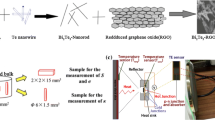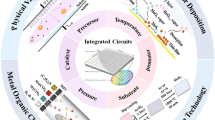Abstract
We present the first-principles calculation to research the electron transfer mechanism between metal and silicon oxide composites for triboelectric nanogenerators. Compared to SiX (X = Cu, Ag, Au and Pt) interface and SiOX interface models, OX interface models have a larger interface separation work and are more stable. OX interface models also have a more significant charge density difference since the O atoms at the interface can store electrons transferred from the metal layer to the SiO2 layer. When Pt atoms and O-terminated SiO2 contact, the formed OPt interface models have a higher magnitude of charge rearrangement. Our calculations also suggest that OPt interface models have a higher electrostatic potential offset, smaller virtual oxide thinning thickness and higher electron potential barrier height. Therefore, the OPt interface models have a longer service life and a stronger ability to store friction-captured electrons.





Similar content being viewed by others
References
Fan FR, Tian ZQ, Wang ZL (2012) Flexible triboelectric generator. Nano Energy 1:328–334
Wang ZL (2021) From contact electrification to triboelectric nanogenerators. Rep Prog Phys 84:096502
Wu CS, Wang AC, Ding WB, Guo HY, Wang ZL (2019) Triboelectric nanogenerator: A foundation of the energy for the new era. Adv Energy Mater 9:1802906
Zhang M, Du HS, Liu K, Nie SX, Xu TT, Si ZXY, CL, (2021) Fabrication and applications of cellulose-based nanogenerators. Adv Compos Hybrid Mater 4:865–884
Wang ZL, Wang AC (2019) On the origin of contact-electrification. Mater Today 30:34–51
Khandelwal G, Maria Joseph Raj NP, Kim SJ (2021) Materials beyond conventional triboelectric series for fabrication and applications of triboelectric nanogenerators. Adv Energy Mater 11:2101170
Bi K, Wang QM, Xu JC, Chen LH, Lan CW, Lei M (2021) All-dielectric metamaterial fabrication techniques. Adv Optical Mater 9:2001474
Liu WJ, Liu ML, Liu XM, Wang XT, Deng HX, Lei M, Wei ZM, Wei ZY (2020) Recent advances of two-dimensional materials in ultrafast photons and fiber lasers. Adv Opt Mater 8:1901631
Saxena P, Shukla P (2021) A comprehensive review on fundamental properties and applications of poly (vinylidene fluoride) (PVDF). Adv Compos Hybrid Mater 4:8–26
Dhanumalayan E, Joshi GM (2018) Performance properties and applications of polytetrafluoroethylene (PTFE) - a review. Adv Compos Hybrid Mater 1:247–268
Kashfipour MA, Mehra N, Zhu JH (2018) A review on the role of interface in mechanical, thermal, and electrical properties of polymer composites. Adv Compos Hybrid Mater 1:415–439
Lin S, Bai XP, Wang HY, Wang HL, Song JN, Huang K, Wang C, Wang N, Li B, Lei M, Wu H (2017) Roll-to-roll production of transparent silver nanofiber network electrode for flexible electrochromic smart window. Adv Mater 29:1703238
Lin S, Wang HY, Wu F, Wang QM, Bai XP, Zu D, Song JN, Wang D, Liu ZL, Li ZW, Tao N, Huang K, Lei M, Li B, Wu H (2019) Room-temperature production of silver-nanofiber film for large-area, transparent and flexible surface electromagnetic interference shielding. npj Flex Electron 3:6
Lin S, Wang HY, Zhang XN, Wang D, Zu D, Song JN, Liu ZL, Huang Y, Huang K, Tao N, Li ZW, Bai XP, Li B, Lei M, Yu ZF, Wu H (2019) Direct spray-coating of highly robust and transparent Ag nanowires for energy saving windows. Nano Energy 62:111–116
Wu J, Wang XL, Li HQ, Wang F, Yang WX, Hu YQ (2018) Insights into the mechanism of metal-polymer contact electrification for triboelectric nanogenerator via first-principles investigations. Nano Energy 48:607–616
Wu J, Wang XL, Li HQ, Wang F, Hu YQ (2019) First-principles investigations on the contact electrification mechanism between metal and amorphous polymers for triboelectric nanogenerators. Nano Energy 63:103864
Li LZ, Wang XL, Zhu PZ, Li HQ, Wang F, Wu J (2020) The electron transfer mechanism between metal and amorphous polymers in humidity environment for triboelectric nanogenerator. Nano Energy 70:104476
Li LZ, Wang XL, Hu YQ, Li ZH, Wang CF, Zhao ZR (2022) Understanding the ferroelectric Polymer-metal contact electrification for triboelectric nanogenerator from molecular and electronic structure. Adv Functional Mater 32:2109949
Antony AC, Thelen D, Zhelev N, Adib K, Manley RG (2021) Electronic charge transfer during metal/SiO2 contact: Insight from density functional theory. J Appl Phys 129:065304
Xu C, Zhang BB, Wang AC, Cai WZ, Zi YL, Feng PZ, Wang ZL (2019) Effects of metal work function and contact potential difference on electron thermionic emission in contact electrification. Adv Funct Mater 29(29):1903142
Tea E, Huang JQ, Hin C (2016) First principles study of band line up at defective metal-oxide interface: oxygen point defects at Al/SiO2 interface. J Phys D: Appl Phys 49:095304
Kresse G, Hafner J (1994) Ab initio molecular-dynamics simulation of the liquid-metal-amorphous-semiconductor transition in germanium. Phys Rev B 49:14251
Kresse G, Furthmüller J (1996) Efficiency of ab-initio total energy calculations for metals and semiconductors using a plane-wave basis set. Comput Mater Sci 6:15–50
Kresse G, Furthmüller J (1996) Efficient iterative schemes for ab initio total-energy calculations using a plane-wave basis set. Phys Rev B 54:11169
Kresse G, Joubert D (1999) From ultrasoft pseudopotentials to the projector augmented-wave method. Phys Rev B 59:1758
Perdew JP, Burke K, Ernzerhof M (1996) Generalized gradient approximation made simple. Phys Rev B 77:3865
Huang JQ, Lin F, Hin C (2019) Density-functional-theory approach to determine band offsets and dielectric breakdown properties across metal/crystal oxide and metal/amorphous oxide interfaces: A case study of Al/SiO2. Appl Surf Sci 483:616–625
Liu XY, Jovanovic D, Stumpf R (2005) First-principles study of Si-SiO2 interface and the impact on mobility. Appl Phys Lett 86:082104
Monkhorst HJ, Pack JD (1976) Special points for Brillouin-zone integrations. Phys Rev B 13:5188e5192
Perdew JP, Ernzerhof M, Burke K (1996) Rationale for mixing exact exchange with density functional approximations. J Chem Phys 105:9982e9985
Adamo C, Barone V (1999) Toward reliable density functional methods without adjustable parameters: The PBE0 model. J Chem Phys 110:6158e6170
Hartwigsen C, Witschel W, Spohr E (1997) Charge density and charge transfer in stage-1 alkali-graphite intercalation compounds. Phys Rev B 55(8):4953
Shan TR, Devine BD, Phillpot SR, Sinnott SB (2011) Molecular dynamics study of the adhesion of Cu/SiO2 interfaces using a variable-charge interatomic potential. Phys Rev B 83(11):115327
Wang Z, Zhang ZF, Shao C, Robertson J, Liu S, Guo YZ (2020) Tuning the high-κ oxide (HfO2, ZrO2)/4H-SiC interface properties with a SiO2 interlayer for power device applications. Appl Surf Sci 527:146843
Tang W, Sanville E, Henkelman G (2009) A grid-based Bader analysis algorithm without lattice bias. J Phys: Condens Matter 21:084204
Stephan R, Hanf MC, Derivaz M, Dentel D, Asensio M, Avila J, Mehdaoui A, Sonnet P, Pirri C (2016) Germanene on Al (111): Interface electronic states and charge transfer. J Phys Chem C 120:1580–1585
Wang CQ, Chen W, Xie JP (2021) Effects of transition element additions on the interfacial interaction and electronic structure of Al (111)/6H-SiC (0001) interface: A First-principles study. Mater 14:630
Huang JQ, Fei L, Celine H (2019) Toward a unified theory correlating electronic, thermodynamic, and mechanical properties at defective Al/SiO2 nanodevice interfaces: An application to dielectric breakdown. ACS Appl Nano Mater 2(11):6836–6848
Sanchez-Portal D, Artacho E, Soler JM (1995) Projection of plane-wave calculations into atomic orbitals. Solid State Commun 95:685–690
Marzari N, Vanderbilt D (1997) Maximally localized generalized Wannier functions for composite energy bands. Phys Rev B 56:12847
Souza I, Marzari N, Vanderbilt D (2001) Maximally localized Wannier functions for entangled energy bands. Phys Rev B 65:035109
Tea E, Huang JQ, Li GC, Hin C (2017) Atomic bonding and electrical potential at metal/oxide interfaces, a first principle study. J Chem Phys 146:124706
Jia BN, Hu YS, Guan XN, Hao JB, Yan BB, Zu YX, Liu G, Zhang Q, Peng GD, Lu PF (2022) Atomic structures and electronic properties of different interface types at Al/c-SiO2 interfaces. Appl Surf Sci 578:151932
Jiang DE, Carter EA (2005) First-principles study of the interfacial adhesion between SiO2 and MoSi2. Phys Rev B 72:165410
Rudenko AN, Keil FJ, Katsnelson MI, Lichtenstein AI (2011) Interfacial interactions between local defects in amorphous SiO2 and supported graphene. Phys Rev B 84:085438
Le HLT, Goniakowski J, Noguera C, Koltsov A, Mataigne JM (2018) Effects of surface hydroxylation on adhesion at zinc/silica interfaces. Phys Chem Chem Phys 122:15581–15588
Christensen M, Dudiy S, Wahnström G (2002) First-principles simulations of metal-ceramic interface adhesion: Co/WC versus Co/TiC. Phys Rev B 65:045408
Guo WB, She ZY, Yang S, Xue HT, Zhang XM (2020) Understanding the influence of Lu, La and Ga active elements on the bonding properties of Sn/SiO2 interfaces from first principle calculations. Ceram Int 46(15):24737–24743
Nagao K, Neaton JB, Ashcroft NW (2003) First-principles study of adhesion at Cu/SiO2 interfaces. Phys Rev B 68(12):125403
Huang JQ, Tea E, Li GC, Hin C (2017) Hydrogen release at metal-oxide interfaces: A first principle study of hydrogenated Al/SiO2 interfaces. Appl Surf Sci 406:128–135
Street RA, Song KW, Northrup JE (2011) Photoconductivity measurements of the electronic structure of organic solar cells. Phys Rev B 83(16):165207
Acknowledgements
We thank for the helpful discussion with Prof. Pengfei Guan and the computational support from the Beijing Computational Science Research Center (CSRC).
Funding
This work was supported by the National Key Research and Development Program of China (No. 2021YFA0718801), the Fundamental Research Funds for the Central Universities (No. 2021XD-A04-2), the Open-Foundation of Key Laboratory of Laser Device Technology, China North Industries Group Corporation Limited (No. KLLDT202103) and the Open Project Program of Shandong Semiconductor Materials and Optoelectronic Information Technology Innovation Center, Ludong University.
Author information
Authors and Affiliations
Contributions
BN Jia took part in investigation; formal analysis; writing - original draft; writing - review & editing. Ming Lei involved in investigation; supervision; writing - review & editing. YY Zou and GY Qin involved in methodology; data curation; formal analysis. ZF Zhang took part in data curation and visualization. LH Han involved in investigation and funding acquisition. Q Zhang took part in investigation. PF Lu took part in conceptualization; funding acquisition; supervision; writing - review & editing. All authors read and approved the manuscript.
Corresponding authors
Ethics declarations
Conflict of interest
The authors declare that they have no conflict of interest.
Additional information
Publisher's Note
Springer Nature remains neutral with regard to jurisdictional claims in published maps and institutional affiliations.
Rights and permissions
Springer Nature or its licensor holds exclusive rights to this article under a publishing agreement with the author(s) or other rightsholder(s); author self-archiving of the accepted manuscript version of this article is solely governed by the terms of such publishing agreement and applicable law.
About this article
Cite this article
Jia, B., Lei, M., Zou, Y. et al. The electron transfer mechanism between metal and silicon oxide composites for triboelectric nanogenerators. Adv Compos Hybrid Mater 5, 3223–3231 (2022). https://doi.org/10.1007/s42114-022-00561-9
Received:
Revised:
Accepted:
Published:
Issue Date:
DOI: https://doi.org/10.1007/s42114-022-00561-9




